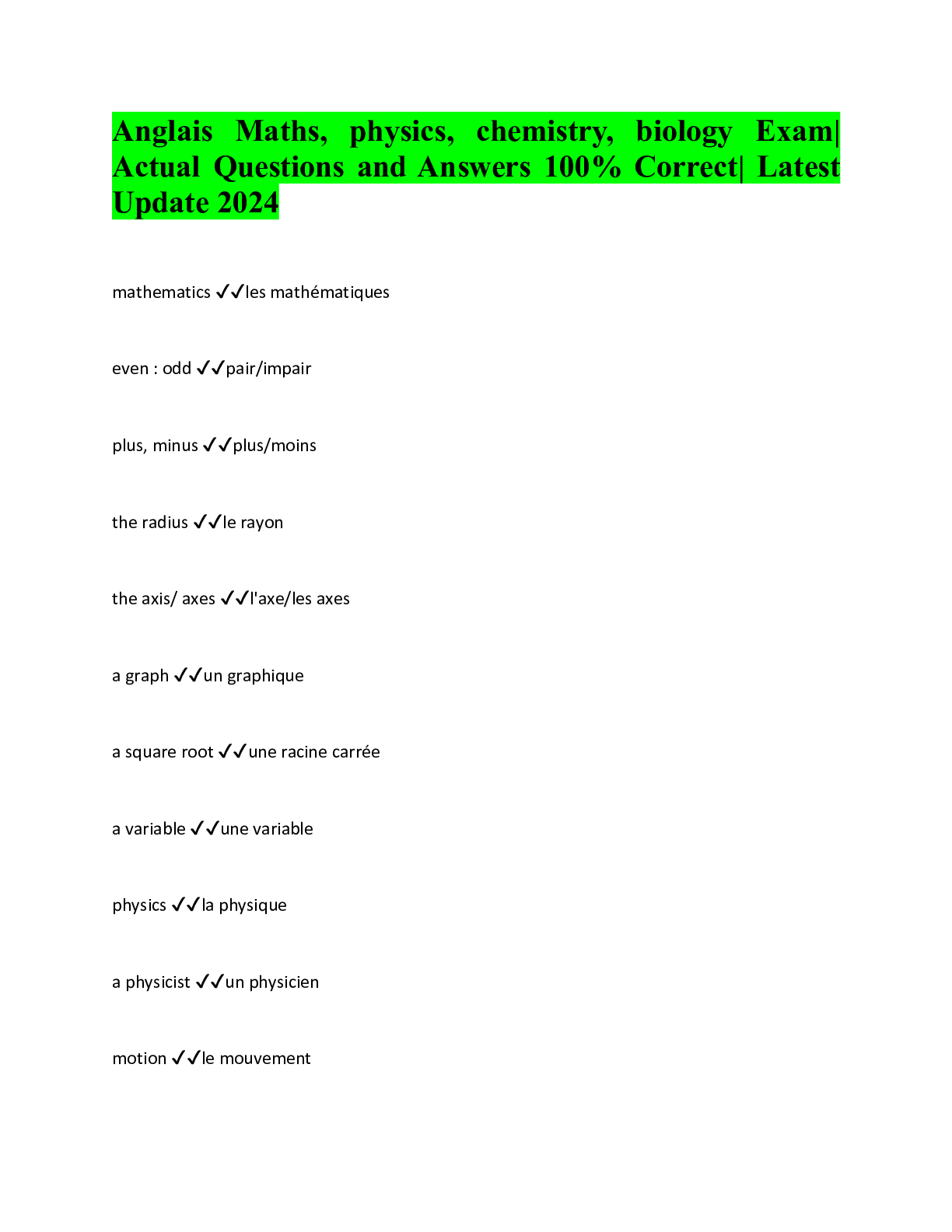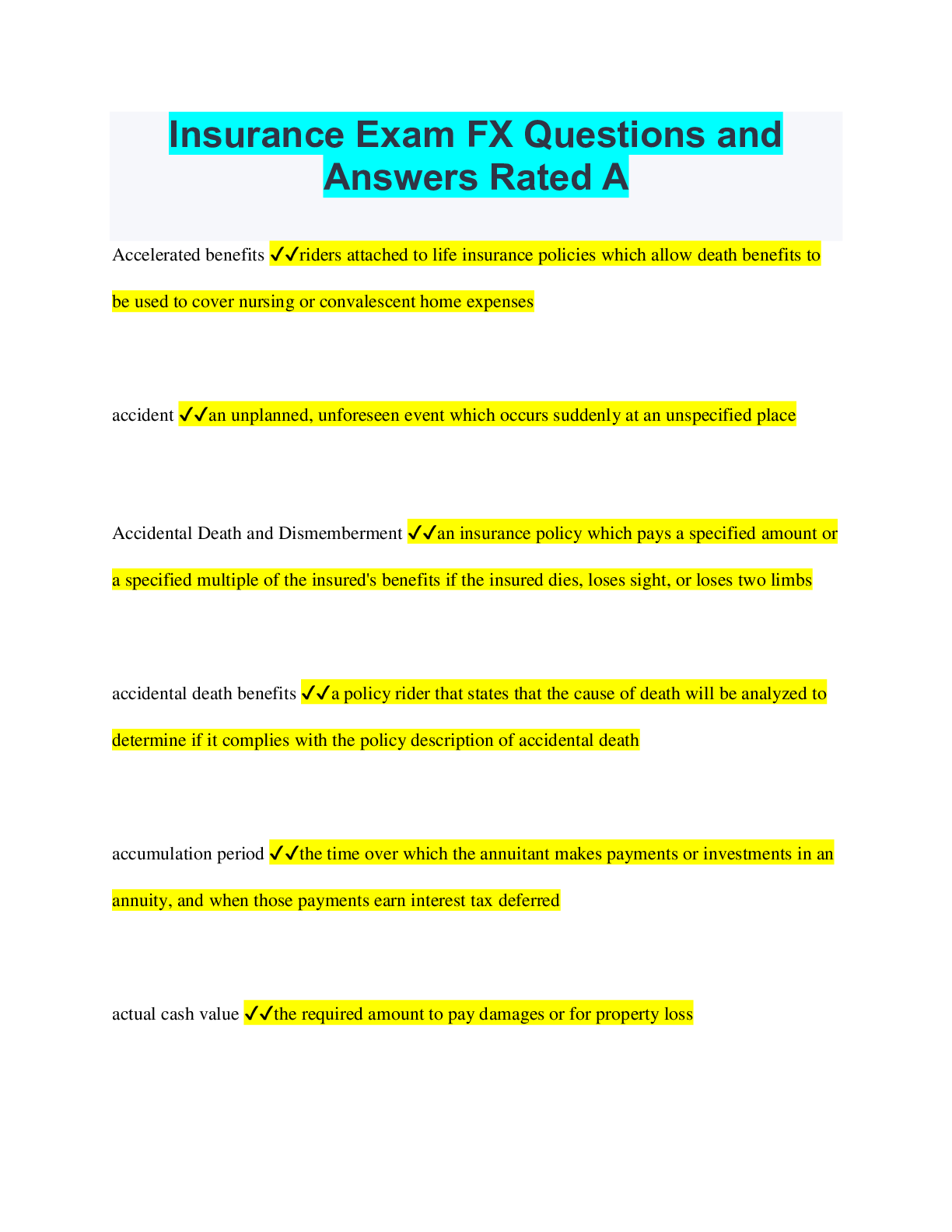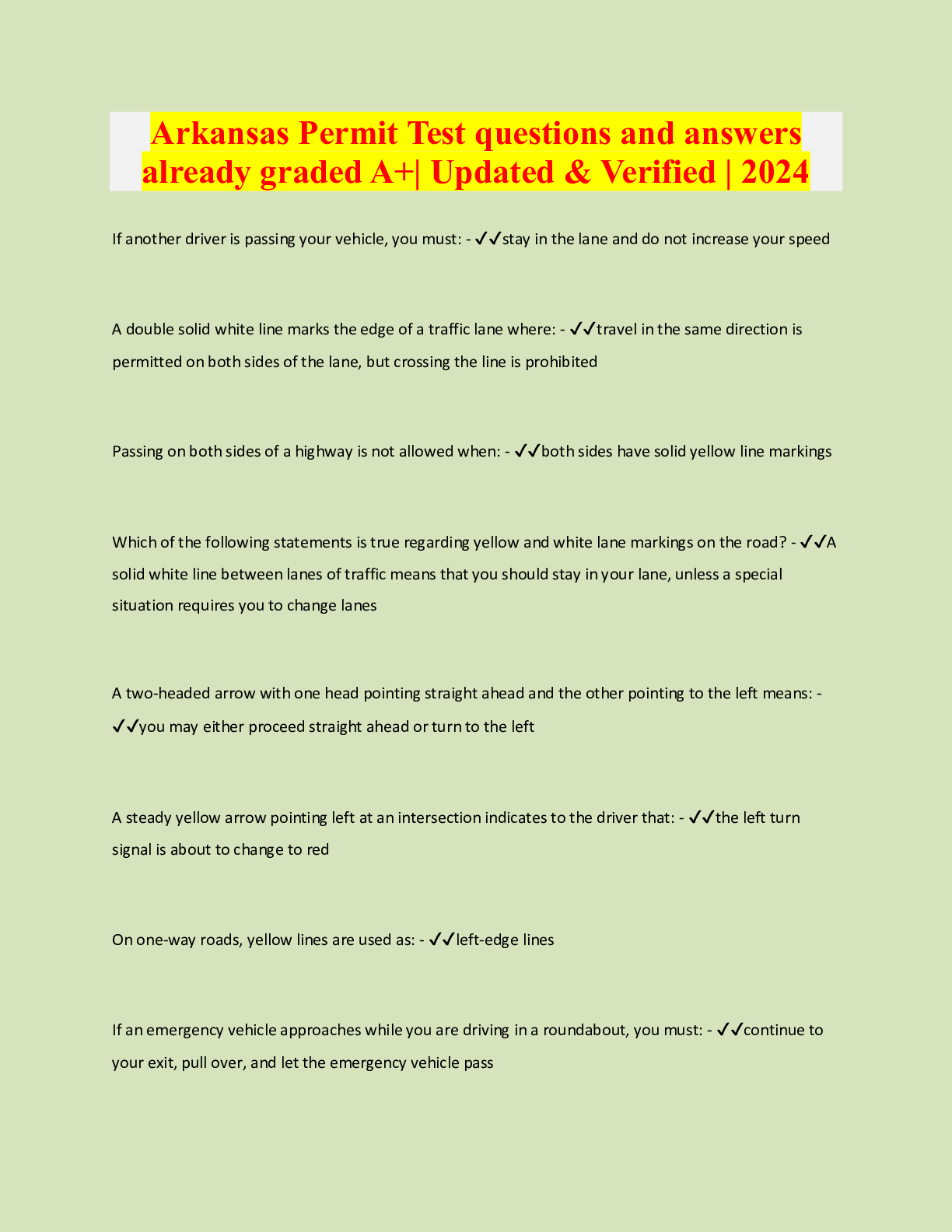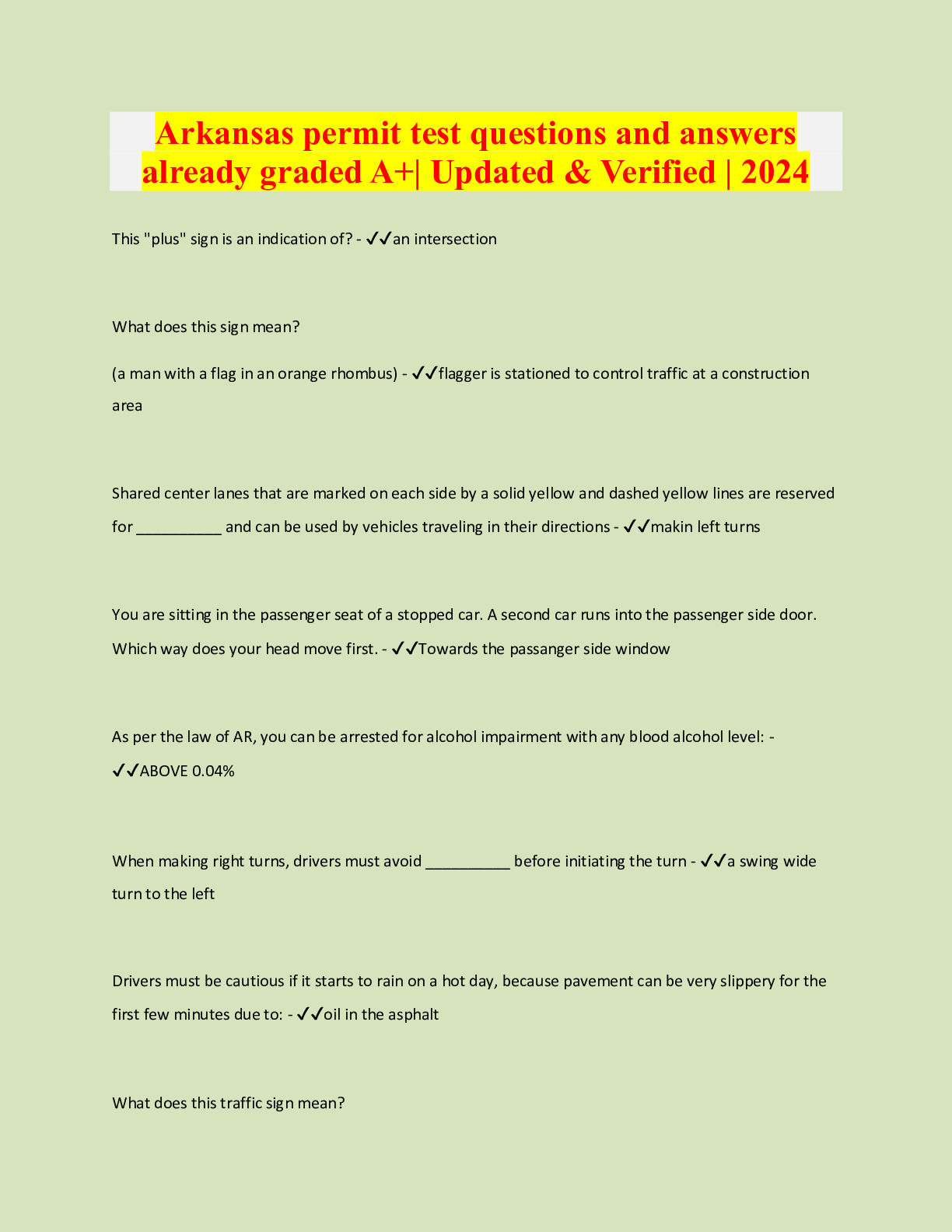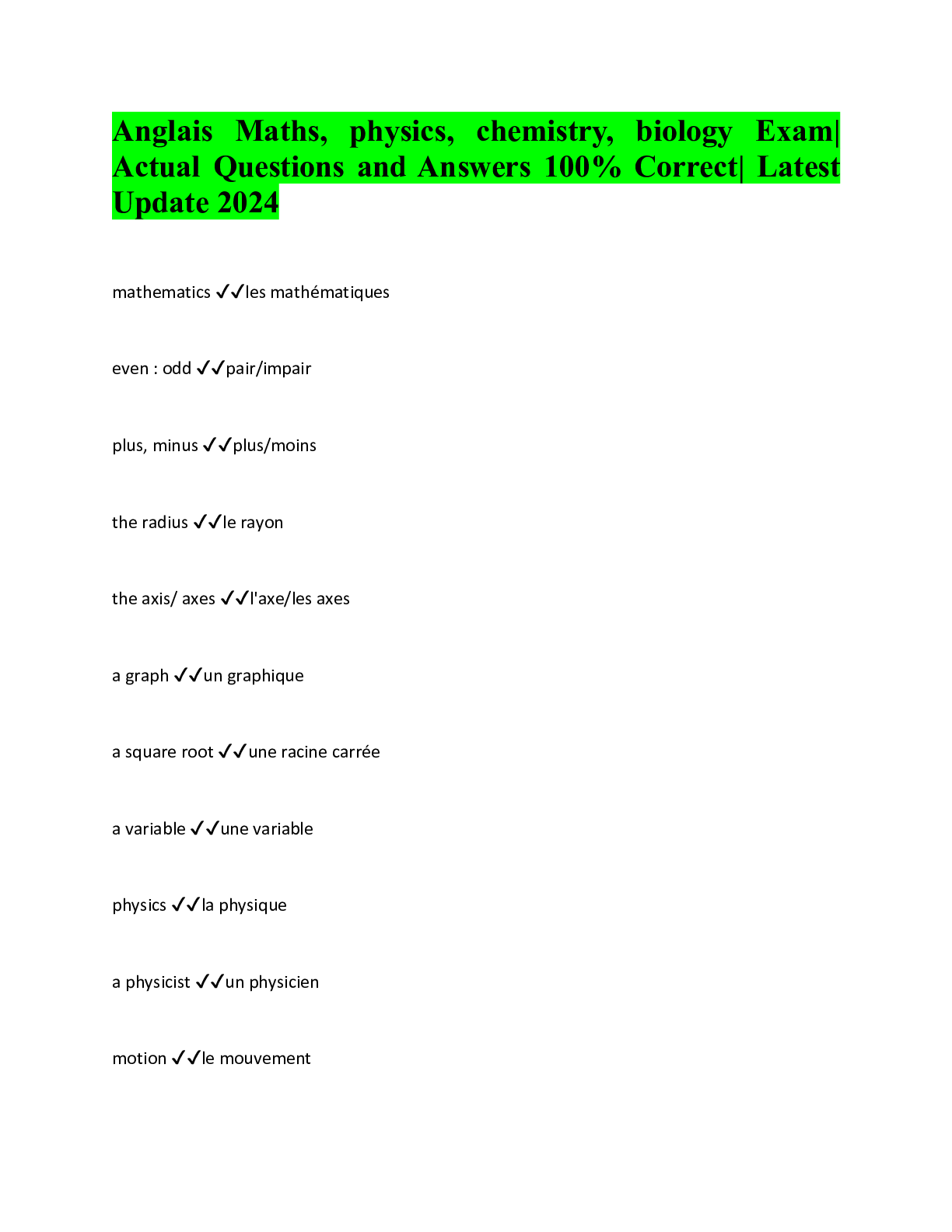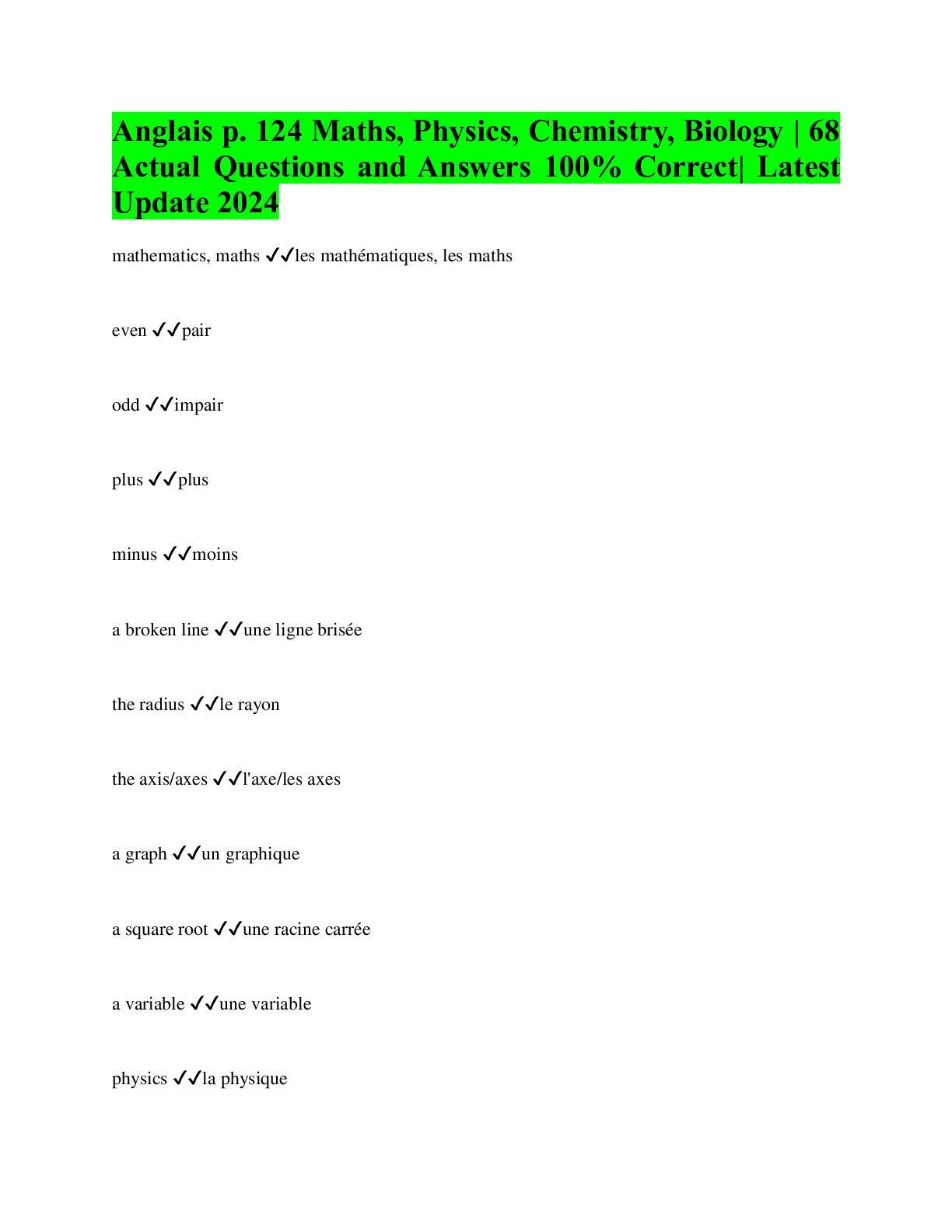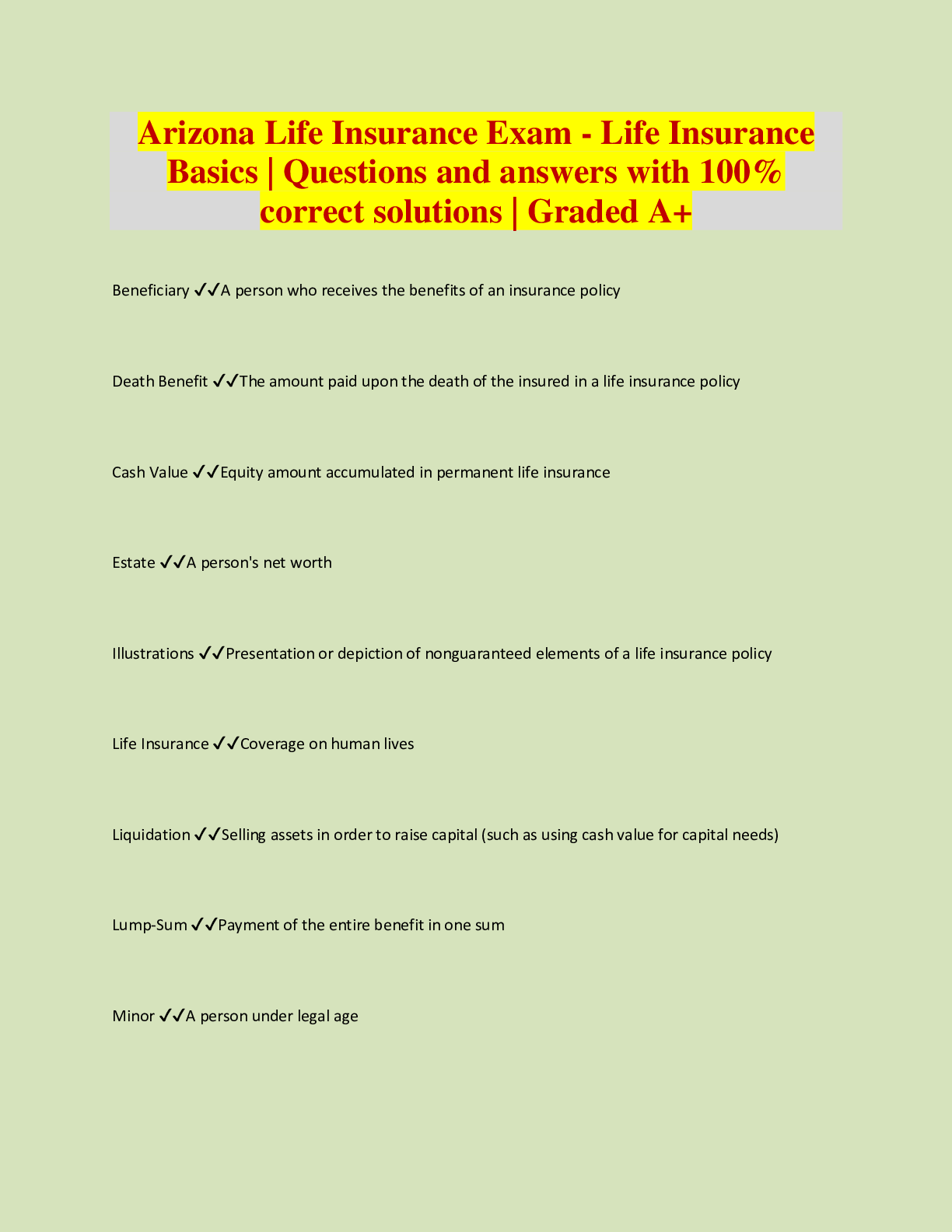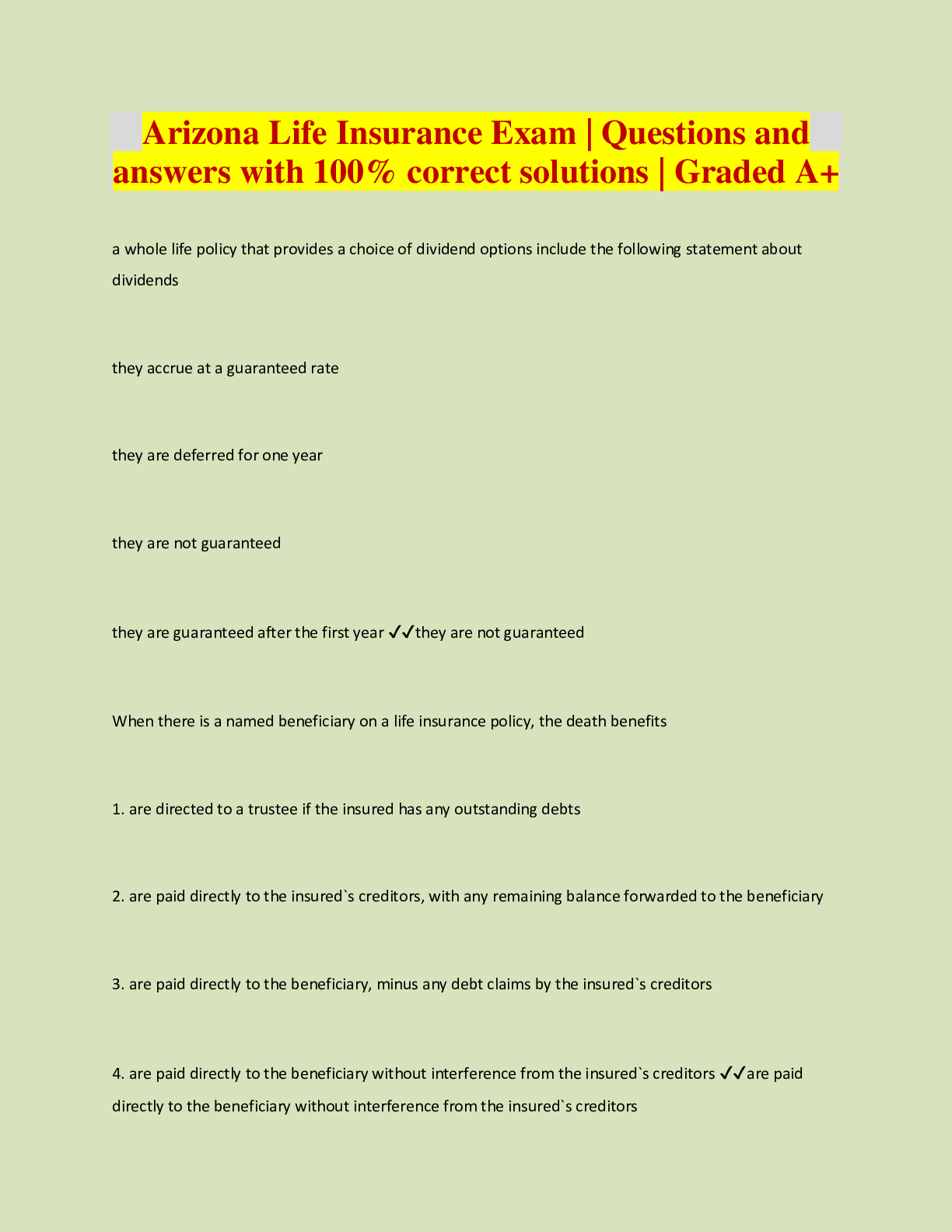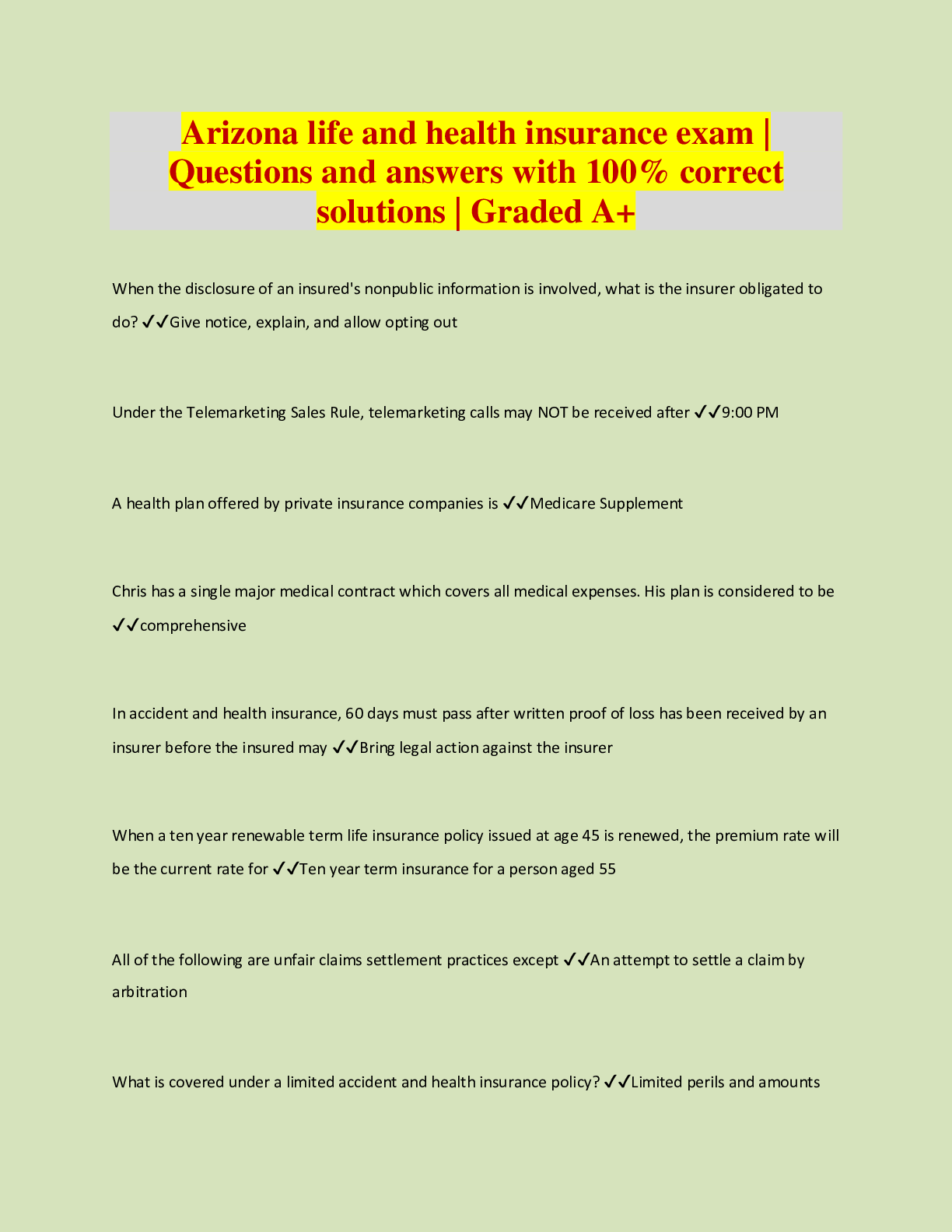Anatomy > EXAM > ATLS Practice Questions and answers already graded A+| Updated & Verified | 2024 (All)
ATLS Practice Questions and answers already graded A+| Updated & Verified | 2024
Document Content and Description Below
Definitive control of the airway is achieved by ____________ - ✔✔Endotracheal intubation How do you treat hypothermia in the ED? - ✔✔crystalloid fluids at 102.2 degrees F and warmed treatmen... t area What does definitive hemorrhage control refer to? (3) - ✔✔1) Possible surgery 2) Stabilizing of pelvis 3) Angioembolization What are rates of fluid administration measured by? - ✔✔Size and length of catheter Minimum flow rate of oxygen reservoir mask - ✔✔11 L/min MCC of shock in trauma pt - ✔✔Hypovolemia due to hemorrhage Describe the 3 for 1 rule - ✔✔Replace each mL of blood loss with 3 ml of crystalloid solution What metabolic state can result from continued hemorrhage or decreased perfusion? - ✔✔Metabolic acidosisIn what survey, primary or secondary, are these identified? 1) Simple PTX 2) Pulmonary contusion 3) Traumatic aortic disruption - ✔✔Secondary Via thorough PE, CXR, pulse ox, ECG and ABG What imaging study is preferred for penetrating abdominal trauma? - ✔✔CT What can FAST rapidly diagnose? - ✔✔Abdominal hemorrhage When is a laparotomy indicated? - ✔✔Fascial penetration with intraperitoneal bleeding or peritonitis What does the Monro Kellie doctrine describe? - ✔✔The relationship between IC volume and pressure Normal resting ICP - ✔✔10 mm Hg How do you reduce elevated ICP? - ✔✔Mannitol in a 20% solution How do you temporarily control pelvic hemorrhage and instability? - ✔✔Internal traction and external counter-pressure How do you initially manage major arterial injury? - ✔✔Direct pressure and fluid resuscitationFull thickness burn - ✔✔Third degree burn What is used to estimate the size and depth of burns? - ✔✔Rule of 9's Head= 9% Each arm=9% Front Trunk= 18% Back Trunk= 18% Upper leg= 9% Lower leg= 9% What type of burns appear wet and blistered? - ✔✔Partial thickness burns (second degree) How do you treat CO exposed pt? - ✔✔100% oxygen flow through non re-breather mask What is a reliable measure of circulating blood volumes in burn patients? - ✔✔Hourly urine output *Goal= 0.5-1.0 ml/kg body weight* Hospital admission criteria for burn pt (8) - ✔✔1) Partial-thickness burns greater than 10% total BSA (TBSA) 2) Full-thickness burns greater than 2% TBSA 3) Burns involving the face, hands, genitalia, perineum, or major joints 4) Circumferential extremity burns5) All high-voltage electrical burns, including lightning injury--Admission of low-voltage electrical burns is selective 6) Chemical burns 7) Inhalation injury 8) Burn injuries in patients with preexisting medical disorders that could complicate management, prolong recovery, or affect mortality (eg, diabetes, immunosuppression) Parkland Formula for Fluid Resuscitation in Burn pt - ✔✔3-4 mL Ringer lactate X weight (kg) X %TBSA burned (second-degree and third degree); *half administered over the first 8 hours* (from time of injury),* remaining half administered over the next 16 hours* What injuries may necessitate inter-hospital transfer? (3) - ✔✔1) Head or spinal cord trauma 2) Pulmonary contusions 3) Severe burns *consider time between injury and definitive care as well as resources available at local facilities* A 34 year old man is injured in a motor vehicle collision. Physical examination is normal except for diffuse abdominal tenderness. He is conscious and vital signs obtained enroute to the hospital are respirations 20 per ,minute, pulse rate is 120 per minute blood pressure 100/60; How should this patient be managed in the field? A. Intravenous fluid at a "keep open" rate B. Intravenous fluid at 20 ml/kg bolus C. Fentanyl 100 mcg intravenousD. Insert an oropharyngeal airway and assist ventilations - ✔✔A. Intravenous fluid at a "keep open" rate What is Sellick's maneuver? A. A method allowing the rescuer to hold a mask on the face with both hands B. A system used to calculate minute volume C. Another name for Mallampati D. Posteriorly directed pressure applied to the cricoid cartilage - ✔✔D. Posteriorly directed pressure applied to the cricoid cartilage A 16 year old girl is rescued from a burning house. She has 25% partial thickness burns, and the burned areas are hot to the touch. What is the appropriate treatment? A. Apply ice to burned areas until cool to touch B. Apply clean water to burned areas for up to 1-2 minutes C. Apply iced water to burned areas until cool to touch D. Do not apply anything to burned areas other than clean sheets - ✔✔B. Apply clean water to burned areas for up to 1-2 minutes What treatment is NOT indicated in the routine management of the patient with a head injury? A. Administration of 100% oxygen B. Fluid resuscitation to a BP of 110-120 systolic if the patient is hypotensive C. Hyperventilating to obtain an EtCO2 of less than 30 D. Stabilization of the cervical spine - ✔✔C. Hyperventilating to obtain an EtCO2 of less than 30Which of the following sets of vital signs is most compatible with a diagnosis of isolated head injury with increasing intracranial pressure? A. BP 170/100, pulse 50/min B. BP 80/60, pulse 130/min C. BP 80/60, pulse 50/min D. BP 170/100, pulse 130/min - ✔✔A. BP 170/100, pulse 50/min Which one of the following is a reason to interrupt the initial assessment? A. Cardiac arrest B. Multiple open (compound) fractures C. Severe head injury with brain tissue visible D. Severe shock - ✔✔A. Cardiac arrest What site is the first choice for intraosseous infusion? A. Proximal tibia B. Distal humerus C. Proximal femur D. Distal fibula - ✔✔A. Proximal tibia A 34 year old man has a gunshot wound to the right groin area. Arterial bleeding, which cannot be controlled with direct pressure, is coming from the wound. The patient appears confused, diaphoretic, and has weak peripheral pulses. What is the appropriate fluid resuscitation for this patient? A. Intravenous fluid at a "keep open" rateB. Apply a hemostatic agent and gain intravenous access given enough fluid to maintain peripheral pulses C. Intravenous fluid at a wide open rate; give at least two liters, then reassess patient D. No intravenous access should be established in this situation - ✔✔B. Apply a hemostatic agent and gain intravenous access given enough fluid to maintain peripheral pulses Which one of the following is typically associated with, post-traumatic hemorrhage, EARLY shock? A. Ventricular dysrhythmias B. Hypotension C. Loss of 30% to 45% of blood volume D. Narrowed pulse pressure - ✔✔D. Narrowed pulse pressure Among the following, what is the most common cause of preventable trauma death in the injured adult patient? A. Airway obstruction B. Cardiac tamponade C. Hemorrhagic shock D. Spinal injury - ✔✔C. Hemorrhagic shock [Show More]
Last updated: 9 months ago
Preview 4 out of 15 pages

Loading document previews ...
Buy this document to get the full access instantly
Instant Download Access after purchase
Buy NowInstant download
We Accept:

Reviews( 0 )
$8.00
Can't find what you want? Try our AI powered Search
Document information
Connected school, study & course
About the document
Uploaded On
Sep 20, 2024
Number of pages
15
Written in
Additional information
This document has been written for:
Uploaded
Sep 20, 2024
Downloads
0
Views
21

